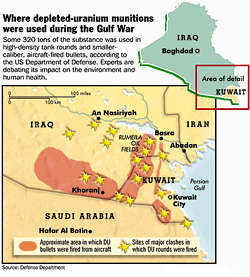Depleted uranium aerosols will permanently contaminate vast regions and slowly destroy the genetic future of populations living in those regions.
Eastern Mediterranean Health Journal - WHO
Depleted uranium: an overview of its properties and health effects
Mar 2002
For some years after the Gulf War, many US and European veterans deployed in the region during the war complained of vague incapacitating symptoms that have been termed ‘Gulf War syndrome’ [5,6]. The US Department of Defense treated this illness as ‘post-traumatic stress disorder’ and advised military doctors to treat it with muscle relaxants and sleeping pills while ordering a mental illness assessment [1]. Arguments about the issue have continued for years, some authors describing it as a myth invented by the media [7], others documenting the symptoms reported by the veterans. These symptoms were multiple, consisting mainly of chronic fatigue, headache, muscle and joint pain, sleep disturbances, bladder dysfunction, sweating disturbances, skin manifestations, menstrual disorders, as well as neurological, psychological, respiratory, gastrointestinal and cardiac symptoms [5,6,8]. Over time, the focus shifted to more serious health risks and a number of dangerous conditions became linked to depleted uranium exposure. These included cancers of different types, renal diseases, as well as congenital anomalies and perinatal deaths among the neonates of veterans [3,9–14]. These health concerns triggered an explosion of interest in the subject as the affected veterans started to campaign for more information about the relationship between their illnesses and exposure to depleted uranium.
If the Gulf War veterans who were temporarily stationed in the region were indeed victims of depleted uranium, what could have been the impact of this substance on the health of the residents of the region and surrounding countries? Most studies from Iraq have concentrated on the impact of the United Nations’ sanctions against Iraq on nutritional deficiencies and on children’s health. A few studies in the Gulf countries have noted an increased incidence of abortion and perinatal and infant mortality since the Gulf War [15–17], but no adequate in-depth research has been performed on the link between the war and serious health conditions. Many issues concerning the effect of depleted uranium on the health of the residents of the war countries and the surrounding regions remain unexplored.
This review of depleted uranium—its origin, properties, uses and impact on the human environment and health—aims to trigger further research on the subject. Internet and MEDLINE searches were performed to extract information on depleted uranium and its health effects. Information was mainly taken from published research on depleted uranium in general and from the Gulf War in particular......The primary stochastic effect associated with radiation exposure is cancer.
.....Exposure to radiation can also affect the reproductive system, causing infertility or damage to the father’s sperm or mother’s egg. Genetic damage is possible, leading to spontaneous abortion, premature death or congenital anomalies. Some forms of genetic damage are not seen in the first or second generations but only later after several generations have passed.
Another danger of exposure to low-dose radiation is biological damage in the form of monocyte depletion, leading to iron deficiency anaemia and a depressed cellular immune system. Radiation also deforms red blood cells, inhibiting their passage into the tiny capillaries and depriving the muscles and brain of adequate oxygen and nutrients. This can lead to impairment of many organs especially the kidneys, liver, lungs and cardiovascular and haematopoietic systems.
Radiation can cause disorders of protein and carbohydrate metabolism, leading to symptoms ranging from severe headache to brain dysfunction. Mental retardation owing to brain damage of the fetus has also been described as a result of radiation exposure in the womb during the critical period when the child’s brain is being formed.
The chemical toxicity of depleted uranium results from its interaction with the biochemical processes of the human body. Chemically, depleted uranium damages kidney function in humans. The proximal tubules are the main site of potential damage. The types of damage that have been observed are nodular changes to the surface of the kidney, lesions to the tubular epithelium and increased levels of glucose and protein in the urine.
Conclusion
If depleted uranium were indeed used in the Gulf War, it will certainly have constituted an enormous health hazard not only to the US and European veterans deployed in the region during the war but also to the residents of the war countries and surrounding areas. The extent of the region affected has not been determined and the long-term dangers remain unidentified.
The Birth Defects of Fallujah
Jan 8 2012
 Image via Wikipedia
Image via Wikipedia Image via Wikipedia
Image via Wikipedia













No comments:
Post a Comment